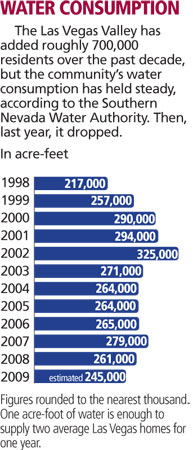Valley water use drops amid recession
Valley residents consumed less water in 2009 than in any year for the past decade. Just don't ask water managers to tell you why.
Southern Nevada Water Authority officials can't definitively explain what caused water use to drop by more than 6 percent from the 2008 total, though several factors are likely at play.
Key among them is the recession, which halted growth in the valley, forced families to tighten their belts and triggered a wave of foreclosures that left thousands of homes vacant.
At many of those homes, the landscaping was left to die either out of simple neglect or by creditors looking to cut their losses.
Add to that the continued impact of communitywide conservation measures launched in 2003, and you've got the makings of a serious shift in consumption, water authority spokesman J.C. Davis said Thursday.
Valley residents and businesses consumed about 245,000 acre-feet of water last year, the lowest total since 1998 when the area was home to roughly 700,000 fewer people.
One acre-foot equals roughly 326,000 gallons, which is enough water to supply two average Las Vegas homes for one year.
Before the economy hit the skids, there were fewer variables to consider when it came to tracking changes in water use, Davis said.
Now it's "hard to pull apart all these threads" to get to the real reasons for the drop in water use.
One thing seems clear: The weather had nothing to do with it. The valley received just 1.59 inches of rainfall last year, roughly one-third of its yearly average of 4.49 inches, but drier conditions did not translate into more outdoor water use.
Davis wouldn't expect it to, either, since changes to the weather here are rarely that severe. In Las Vegas, the difference between a dry year and a wet year can mean "we got six good storms instead of eight," he said.
"Weather is only a factor if behavior changes to accommodate it," Davis said.
What has changed people's behavior are the mandatory watering schedules and the restrictions on lawns at homes and businesses built since 2003. That same year, the water authority dramatically increased the rebates it pays to people willing to replace their turf with desert landscaping.
The turf-rebate program now pays $1.50 for every square foot of grass removed.
Regardless of whether the recent decline in water consumption came by choice or circumstance, Davis said, "the bottom line is the community has adopted the conservation ethic."
Last year's water use figures were announced during Thursday's water authority board meeting as part of a drought update. The monthly update also included a bleak forecast for the Colorado River, which fills Lake Mead and supplies 90 percent of the valley's drinking water.
The latest federal projections call for the Colorado to flow about 77 percent of average as it carries melting snow from the western slope of the Rocky Mountains later this year.
Last year, the river's flow into the upstream reservoir of Lake Powell was 88 percent of normal, continuing a trend of below-average volume that dates back to the start of the current drought a decade ago.
But there is some good news on the horizon, said Kay Brothers, deputy general manager for the water authority. The current projections are based on snowpack data collected through Jan. 12 and do not include the series of heavy winter storms now sweeping the West.
"Our next report will be different," Brothers said.
Contact reporter Henry Brean at hbrean@reviewjournal.com or 702-383-0350.

















